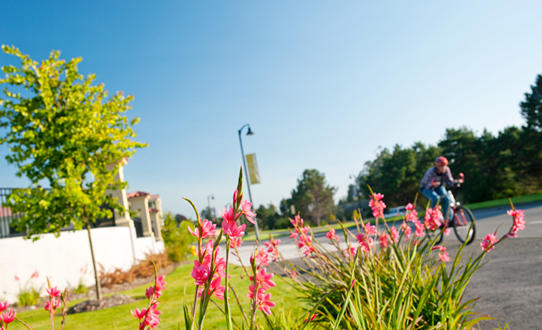The seven-page document includes hundreds of plant species—many native to California—that will guide the university’s landscaping projects.
“Our goal was to create a comprehensive guide for future landscaping projects but also to provide students and professors with a hands-on learning resource,” says HSU Grounds and Landscape Manager Doug Kokesh, a member of the six-person committee.

The university’s previous campus plant list was drafted by landscape architecture firm Cotton and Taniguchi in 2008, Kokesh says. That document guided several campus landscaping projects including the College Creek Apartments, Harry Griffith Hall, Redwood Plaza and the Kinesiology and Athletics Building.
Last year, the university assembled a group of HSU faculty and staff to update the Campus Landscape Standards & Design Guidelines.
Led by Senior Director of the Department of Facilities Planning, Design & Transportation Management Traci Ferdolage, the committee consisted of Kokesh, Housing’s Lead Groundsworker Sue Buckley and faculty members John Stuart, Michael Mesler and Michael Kauffmann.
The group spent several months combing through the 200-item list, identifying flowers, shrubs and trees successful on the North Coast like redwood trees, rhododendrons, azaleas and irises. “For each plant, we asked: would it grow here, would it do well and would it look good?” Kokesh explains. “Even the folks from the Miller Farms Nursery in McKinelyville were helpful with cultivar selections for several species.”
HSU Biological Sciences Professor Michael Mesler, who frequently uses the university’s landscaping as an outdoor classroom, says the group also selected species based on their perceived educational value to botany students.
“Viewing living plants is an extremely valuable resource, especially at a campus like ours which is so rich with flora,” Mesler says.
In addition to housing the largest herbarium in the California State University system, HSU is frequently recognized for the diversity of its flora. Earlier this year, the California Garden Clubs, Inc.’s Landscape Design Council recognized the university for its excellence in land use, landscape design and maintenance.
The award also cited HSU landscaping for its abundant use of native plants, trees and colorful foliage.
Moving forward, the university plans to update the campus plant list every five years, Kokesh says. Input from various sources will be solicited and encouraged.
The following two landscaping projects, which were completed over the summer, were guided by the university’s updated campus plant list:
- The university cleared the lot that housed the former fire-training house at the corner of Granite Street and LK Wood to create a small wayside park. They planted various native plants and trees including: redwoods, cedar, redbud, azaleas, irises and rhododendron.
- The university created an island and perimeter planters adjacent to the G-11 Parking Lot south of the Sculpture and Ceramics Labs. Plants and trees include: dwarf juniper, rosemary, lavender, Oregon grape, maples, azaleas, Douglas iris, dogwood and rhododendron.
To view the updated campus plant list, click here.